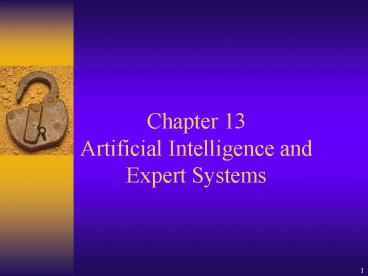Chapter 13 Artificial Intelligence and Expert Systems - PowerPoint PPT Presentation
1 / 24
Title:
Chapter 13 Artificial Intelligence and Expert Systems
Description:
Artificial Intelligence and Expert Systems Artificial Intelligence in Business Artificial Intelligence in Business (Cont.) Artificial Intelligence Attempt to emulate ... – PowerPoint PPT presentation
Number of Views:413
Avg rating:3.0/5.0
Title: Chapter 13 Artificial Intelligence and Expert Systems
1
Chapter 13Artificial Intelligence andExpert
Systems
2
Artificial Intelligencein Business
3
Artificial Intelligencein Business (Cont.)
- Artificial Intelligence
- Attempt to emulate the human mind in machines
- Robotics
- Robots used to replace human laborers
- Artificial Vision
- Allows robots that move in space sense obstacles
- Used in machines for sorting and identification
4
Artificial Intelligencein Business (Cont.)
- Natural Language Processing
- Programs that recognize human commands
- Expert Systems
- Programs that simulate human expertise
- Neural Networks
- Programs built to solve problems while learning
and refining their knowledge
5
Artificial Intelligencein Business (Cont.)
6
Artificial Intelligencein Business (Cont.)
- Fuzzy Logic
- Based on rules that have no discrete boundaries
but lies along a continuum - E.g. uses probabilities to decide
- More closely mimics human problem solving
- Used in appliances, locomotives, managerial
decision making
7
Artificial Intelligencein Business (Cont.)
8
Artificial Intelligencein Business (Cont.)
9
Artificial Intelligencein Business (Cont.)
- Genetic Algorithms
- Mathematical functions that use Darwinian
principals to improve an application - Intelligent Agents
- Automatically wade through massive amounts of
data to select and deliver the most suitable
information
10
Artificial Intelligencein Business (Cont.)
11
Contribution ofExpert Systems
- Planning
- Decision making
- Monitoring
- Diagnosis
- Training
12
Contribution ofExpert Systems (Cont.)
- Incidental learning
- Replication of expertise
- Timely response
- Consistent solutions
13
Development ofExpert Systems
- What is Expertise?
- Skill and knowledge whose input into a process
results in performance high above the norm - Components of Expert Systems
- The interface or dialog
- The knowledge base
- The interface engine
14
Development ofExpert Systems (Cont.)
15
Construction of Expert Systems
- IF-THEN Rules
- Most popular method of knowledge representation
- Also called production rules
- Systems hold facts in the form of IF-THEN
statements
16
Construction of Expert Systems (Cont.)
17
Construction of Expert Systems (Cont.)
- Knowledge Engineering
- Asking experts appropriate questions and
translating into a knowledge base - Some ESs take years
- Knowledge engineer programmer who specializes in
developing ESs
18
Construction of Expert Systems (Cont.)
- Expert System Shells
- Expert System that has been emptied of its
knowledge - Used to build new ES
- Forward Chaining
- Result-driven process (forward reasoning)
- E.g.if invest 100K in bonds, forward chaining
will predict 3 pa interest. - Backward Chaining
- Goal-driven process (backward reasoning)
- E.g. if investor wants to earn at least 15pa,
Backward Chaining will recommend investing in
investment shares.
19
Construction of Expert Systems (Cont.)
20
Factors Justifying the Acquisition of Expert
Systems
21
Expert Systems in Action
- Medical management
- Telephone network maintenance
- Credit evaluation
- Tax planning
- Detection of insider securities trading
- Detection of common metals
22
Expert Systems in Action (Cont.)
- Mineral exploration
- Irrigation and pest management
- Diagnosis and prediction of mechanical failure
- Class selection for students
23
Limitations of Expert Systems
- Three limitations of ESs
- Can handle only narrow domains
- Do not possess common sense
- Have a limited ability to learn
- Human experts may be reluctant to share expertise
- Difficult and expensive to construct
24
Summary
- Artificial intelligence has some basic concepts
- Artificial intelligence is used in business and
other fields - Expert systems are helpful in solving
unstructured problems - Knowledge gathering is important for knowledge
bases








![Artificial Intelligence Lecture 8: [Part I]: Selected Topics on Knowledge Representation PowerPoint PPT Presentation](https://s3.amazonaws.com/images.powershow.com/7421234.th0.jpg?_=20151128083)






















